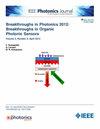Photonics Breakthroughs 2024: Multidimensional Integrated (de)Multiplexers for Optical Fiber Communications
IF 2.1
4区 工程技术
Q3 ENGINEERING, ELECTRICAL & ELECTRONIC
引用次数: 0
Abstract
The growing demand for higher data transmission capacity, particularly driven by advancements in artificial intelligence and cloud computing, has spurred the exploration of various degrees of freedom (DoF) of light in optical communication systems, including wavelength, polarization, and spatial modes. Consequently, multidimensional optical multiplexing has emerged as a pivotal enabling technology. However, the development of compact, cost-effective, and scalable multidimensional optical interconnects remains a significant challenge. In this work, we present our recently demonstrated ultra-compact multiplexer fabricated on silicon, capable of selectively launching eight spatial and polarization modes into a few-mode optical fiber with a footprint of less than光子学突破2024:光纤通信的多维集成(de)多路复用器
对更高数据传输容量的需求不断增长,特别是在人工智能和云计算的进步推动下,刺激了光通信系统中各种自由度(DoF)的探索,包括波长、偏振和空间模式。因此,多维光复用已经成为一种关键的使能技术。然而,开发紧凑、经济、可扩展的多维光互连仍然是一个重大挑战。在这项工作中,我们展示了我们最近展示的在硅上制造的超紧凑型多路复用器,能够选择性地将8种空间和偏振模式发射到占用面积小于$35\ × 35$ μ$\math {m^{2}}$的少模光纤中。线极化(LP)模式$\text{LP}_{01-x/y}$、$\text{LP}_{11a-x/y}$、$\text{LP}_{11b-x/y}$和$\text{LP}_{21b-x/y}$对应的峰值耦合效率分别为−3.8 dB、−5.5 dB、−3.6 dB和−4.1 dB。与以前的方法相比,我们的装置以超紧凑的方式促进了不同LP模式的选择性激发,同时保持了极化多样性和竞争耦合效率。此外,我们回顾了基于光子集成电路的多维光复用的最新进展。我们还讨论了与我们提出的方法相关的主要挑战,并讨论了未来的方向,包括增强策略和潜在的应用。
本文章由计算机程序翻译,如有差异,请以英文原文为准。
求助全文
约1分钟内获得全文
求助全文
来源期刊

IEEE Photonics Journal
ENGINEERING, ELECTRICAL & ELECTRONIC-OPTICS
CiteScore
4.50
自引率
8.30%
发文量
489
审稿时长
1.4 months
期刊介绍:
Breakthroughs in the generation of light and in its control and utilization have given rise to the field of Photonics, a rapidly expanding area of science and technology with major technological and economic impact. Photonics integrates quantum electronics and optics to accelerate progress in the generation of novel photon sources and in their utilization in emerging applications at the micro and nano scales spanning from the far-infrared/THz to the x-ray region of the electromagnetic spectrum. IEEE Photonics Journal is an online-only journal dedicated to the rapid disclosure of top-quality peer-reviewed research at the forefront of all areas of photonics. Contributions addressing issues ranging from fundamental understanding to emerging technologies and applications are within the scope of the Journal. The Journal includes topics in: Photon sources from far infrared to X-rays, Photonics materials and engineered photonic structures, Integrated optics and optoelectronic, Ultrafast, attosecond, high field and short wavelength photonics, Biophotonics, including DNA photonics, Nanophotonics, Magnetophotonics, Fundamentals of light propagation and interaction; nonlinear effects, Optical data storage, Fiber optics and optical communications devices, systems, and technologies, Micro Opto Electro Mechanical Systems (MOEMS), Microwave photonics, Optical Sensors.
 求助内容:
求助内容: 应助结果提醒方式:
应助结果提醒方式:


